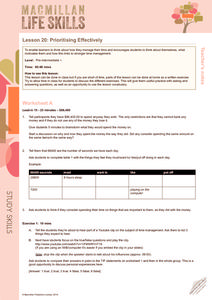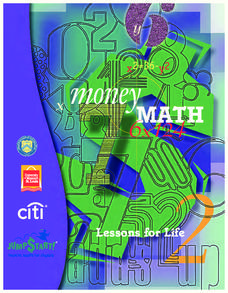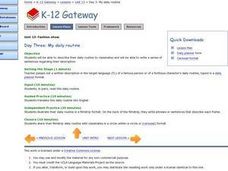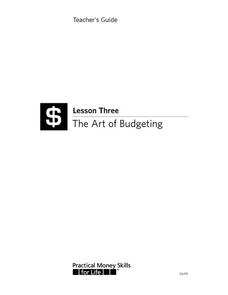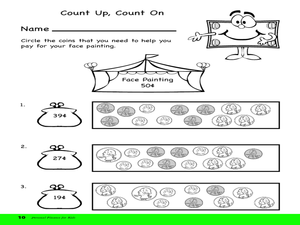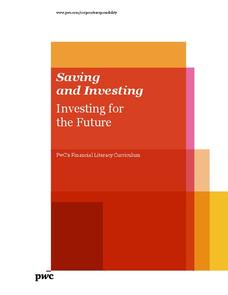Macmillan Education
Prioritising Effectively
How do you determine the things you must do during your day from those that you want to do, or are willing to put off? Time management and prioritizing effectively are the focus of this life skills lesson, which includes worksheets,...
Curated OER
Home Living / Daily Living: Shopping List 2
I've done this exercise with my special needs learners more times than I can count. They practice getting ready to shop at the grocery store by identifying items on their shopping list. They match grocery items to the proper department...
Visa
Money Responsibility
Introduce young learners to the important life skill of responsibly managing money and recording how much they spend and save.
Visa
Dream Big: Money and Goals
Whether their objective is independent living, going to college, or buying a car, pupils will participate in discussions and complete worksheets to gain an understanding of how short- and long-term goals play a large role in helping...
University of Missouri
Money Math
Young mathematicians put their skills to the test in the real world during this four-lesson consumer math unit. Whether they are learning how compound interest can make them millionaires, calculating the cost of remodeling...
University of Missouri
Money Math
Wouldn't your class members love to become millionaires? It doesn't happen overnight. Teach young entrepreneurs about personal finance and money management with a series of lessons focused on money math. Pupils learn about...
Curated OER
Recycling: Responsible Behaviors
Take the time to teach learners with moderate disabilities how to identify recyclable materials. They learn how to recycle as a mode of social responsibility and community involvement. They practice identifying and sorting recyclable...
Curated OER
Money Management Part II: Checking Accounts
Having money is great, learning to manage it wisely is imperative. First, the class has a discussion on the value and convenience of having a checking account. Then, they practice filling out deposit slips, keeping an account register,...
Curated OER
My Daily Routine
Foreign language learners work in pairs to translate the daily routine of celebrities or everyday people, presented in daily planner format, into English. They then illustrate and record their own daily routines in storyboard (film...
Curated OER
Cashing a Check and Using an ATM
Banking is a key skill all individuals should practice. Provide a hands-on exercise to encourage the proper method of writing a check and using an ATM. The activity prompts special needs learners with full assistance until mastery is...
Visa
The Influence of Advertising
Pupils become informed consumers and citizens with this lesson on the influence of advertising, identifying basic advertising techniques and discriminating between fact and claim in modern advertisements and commercials.
Curated OER
Checkbook
Develop life skills through the use of an AppleWorks Banking kit, a spreadsheet program, and a role play activity. This life skills lesson utilizes technology plus busines and social studies principles. Note: All materials...
Curated OER
Math In Everyday Life
Second and third graders solve word problems involving both time and money. First the class works together to solve basic addition, subtraction, multiplication, and simple fraction problems (these examples are provided). After solving...
Curated OER
Two-Step Problems and Money Concepts
Elementary schoolers solve two-step equations and practice money concepts. They solve multi-step addition and subtraction contextual problems and apply money concepts to real life situations. Pupils use pictures and counters to help them...
Perkins School for the Blind
Integrated Skills - Laundry
I hate doing laundry, even if it is an independent living skill that requires me to count money, follow a sequence, and sort clothing by color. Learners with multiple disabilities discuss what laundry is, why they need to do it, and how...
Alabama Learning Exchange
Coins to Bills!
Students practice using money at a grocery store. For this money lesson, students get familiar with grocery store ads and work in pairs to use these ads to select food items to purchase using money manipulatives. Students practice being...
Wells Fargo
Hands on Banking
Cha-ching! You just hit the jackpot with this interactive consumer math unit. Supported by a series of online lessons and activities, these lessons engage students in applying their math skills to real-life personal...
Visa
The Art of Budgeting
Class members learn how to set up and maintain a personal budget through discussion, financial planning worksheets, and a brief PowerPoint presentation.
Missouri Department of Elementary
How Much Does Smoking Really Cost?
Following a brief survey about tobacco, scholars examine a fact sheet to answer questions about the substance. A practice page challenges the class to determine the cost of the habit using money math. Pupils discuss their findings...
Curated OER
Counting Change and Changing Coins
Second graders demonstrate how to count change. In this consumer math lesson, 2nd graders read the book The Penny Pot and identify the value of coins. Students complete a worksheet to practice counting coins.
Wells Fargo
Hands on Banking
Encourage middle schoolers to be proficient and knowledgeable in the economic world with a series of personal finance lessons. Focusing on banking, credit, budgets, and investing, the activities guide learners through financial...
Curated OER
Money Math
Students explore a story about a room decoration activity to learn about measurements and area. In this measurement lesson, students listen to a story about a boy who is redecorating his bedroom. Students discuss the story and work in...
PwC Financial Literacy
Saving and Investing: Investing for the Future
A fine lesson on saving and investing is here for you and your middle schoolers. In it, learners explore the values of time and money, and discover how small amounts of money invested over time can grow into a large "pot of gold." They...
Curated OER
Adding Pennies, Nickels and Dimes
Students add pennies, nickels and dimes and organize the coins to display a variety of price values from real life examples. They discuss the importance of money in the day-to-day world.


